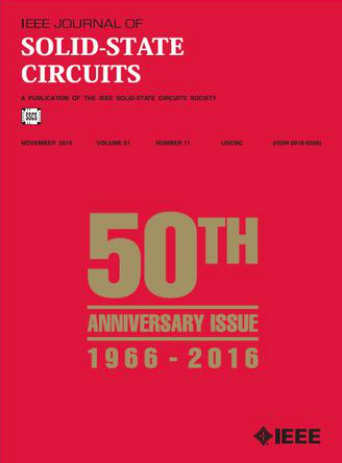具有隐式参考倍增和同步频率/占空比校准的乒乓电荷共享锁相环
IF 5.6
1区 工程技术
Q1 ENGINEERING, ELECTRICAL & ELECTRONIC
引用次数: 0
摘要
我们提出了一种新的乒乓(PP)电荷共享锁定(CSL)锁相环(PLL)架构,该架构在参考时钟的正负两半使用互补的电荷共享电容器增强了注入振荡器LC-tank的电荷强度,有效地实现了隐含的2倍参考频率乘法。该设计包括一个同步频率跟踪回路(FTL)和一个用于鲁棒PVT跟踪的占空比校准(DCC)回路,采用一个超低功率的bang-bang鉴相器(BB-PD)。f3类振荡器及其三次谐波提取器产生~27 GHz输出。在28 nm CMOS中实现的PP-CSL锁相环,与传统CSL锁相环相比,注入强度增加了三倍,同时解决了负载调制问题,并将参考杂波提高了约15 dB。它实现了42秒的超低rms抖动,功耗仅为14兆瓦,从而产生了出色的抖动归一化值($\rm FoM_{{\ maththrm {jitter}}{-}N}$) - 276.6 dB。本文章由计算机程序翻译,如有差异,请以英文原文为准。
A Ping-Pong Charge-Sharing Locking PLL With Implicit Reference Doubling and Simultaneous Frequency/Duty-Cycle Calibrations
We propose a new ping-pong (PP) charge-sharing locking (CSL) phase-locked loop (PLL) architecture that enhances the strength of charge-injection into the oscillator’s LC-tank using complementary charge-sharing capacitors during both positive and negative halves of the reference clock, effectively achieving an implicit $2\times $ reference frequency multiplication. The design includes a simultaneous frequency-tracking loop (FTL) and duty-cycle calibration (DCC) loop for robust PVT tracking, employing an ultralow-power bang-bang phase-detector (BB-PD). A class-F3 oscillator along with its third harmonic extractor generate the ~27 GHz output. Implemented in 28 nm CMOS, the PP-CSL PLL demonstrates a threefold increase in injection strength compared to the conventional CSL PLLs, while resolving the load-modulation issue and improving the reference spur by ~15 dB. It achieves an ultralow rms jitter of 42 fs with a power consumption of only 14 mW, resulting in an outstanding jitter-normalized figure of merit ( $\rm FoM_{{\mathrm { jitter}}{-}N}$ ) of −276.6 dB.
求助全文
通过发布文献求助,成功后即可免费获取论文全文。
去求助
来源期刊

IEEE Journal of Solid-state Circuits
工程技术-工程:电子与电气
CiteScore
11.00
自引率
20.40%
发文量
351
审稿时长
3-6 weeks
期刊介绍:
The IEEE Journal of Solid-State Circuits publishes papers each month in the broad area of solid-state circuits with particular emphasis on transistor-level design of integrated circuits. It also provides coverage of topics such as circuits modeling, technology, systems design, layout, and testing that relate directly to IC design. Integrated circuits and VLSI are of principal interest; material related to discrete circuit design is seldom published. Experimental verification is strongly encouraged.
 求助内容:
求助内容: 应助结果提醒方式:
应助结果提醒方式:


